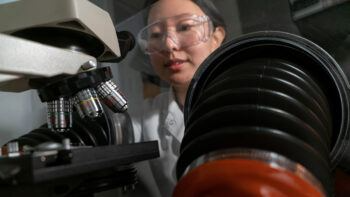How Do Bacteria Survive Antibiotics?
Researchers investigate the energy that powers bacterial growth to understand how bacteria develop antibiotic resistance.

Researchers at Texas A&M University measure intense electric fields in bacterial cells to study diverse origins of antibiotic tolerance.
Texas A&M Engineering
Bacteria that develop genetic resistance to antibiotics cause millions of human deaths annually. Yet genetic resistance is only one way bacteria can survive antibiotics.
Researchers from Texas A&M University investigated variations in the electrochemical energies that power bacterial growth to understand how bacteria develop antibiotic tolerance without acquiring new genes or mutating existing ones. These energies are intense: the contributing electric field in a single bacterium can be stronger than those in lightning bolts.
“Bacteria have developed numerous adaptation strategies over billions of years to survive in adverse environments,” said Dr. Pushkar Lele, associate professor in the Artie McFerrin Department of Chemical Engineering at Texas A&M. “Most mechanisms of adaptation are yet to be understood.”
Every year, approximately 3 million pounds of antibiotics are used in human medicine, and eight times that amount is used to keep livestock healthy for human consumption. Unfortunately, excess and untargeted use of antibiotics can create conditions that are ripe for the emergence of antibiotic resistance in bacteria.
Previous studies have noted that individual bacterial cells lacking sufficient energy frequently survive lethal doses of antibiotics. These dormant cells may not possess genes that can confer resistance to antibiotics. Instead, they sleep through the antibiotic attack.
“Antibiotics eliminate actively growing bacteria, usually by targeting key processes in the cell,” Lele said. “In a dormant bacterium, those processes may be stymied, rendering the antibiotics ineffective. High energy levels, in fact, are considered detrimental to their chances of survival.”
The team was surprised, therefore, when they observed surviving cells of Escherichia coli swimming rapidly for several hours in the presence of antibiotics. Bacteria swim by rotating slender appendages called flagella. The flagella are rotated several hundred times each second by strong electric fields across the cell membrane. Thus, the experiments suggested, against the grain of conventional wisdom, that survivors maintain high electrochemical energies.
To investigate the correlation between cell energy and antibiotic tolerance, the researchers treated cells with several antibiotic combinations. Using fluorescent dyes and sensitive photon detection techniques, they monitored the electrochemical energy levels in surviving cells. The cells unexpectedly exhibited a wide range of energies despite being in a state of arrested growth.
Next, the team determined how the survivors might respond to subsiding levels of antibiotics if the treatment was truncated. Working at a single-cell level, they discovered that cells with high energies began growing immediately once the antibiotic threat was removed, demonstrating the perils of incomplete antibiotic courses.
The results suggest that some bacteria can survive the antibiotic onslaught even if they are neither dormant nor resistant. Worryingly, such bacteria retain the ability to swim out of harmful environments and spread rapidly. Plus, high energy retention enables them to adapt to the antibiotics in various ways.
“The energy source in E. coli that powers motility also powers many transporters, often called efflux pumps,” Lele said. “These transporters can pump antibiotics out of the cell to mitigate the threat. The swimming cells we observed possibly adapted via this mechanism.”
Medical treatment often involves switching to a different antibiotic if an infected patient fails to respond to initial antibiotic intervention. According to Lele, the fascinating aspect of their discovery is that cells with high energies survive more frequently when antibiotics are switched than when a single antibiotic is used.
“Our findings also suggest that despite being genetically identical, cells in a population can and do employ diverse mechanisms to adapt to antibiotic stress,” Lele said. “Treatment regimens would have better outcomes if they accounted for such diversity.”
The team published their findings in an American Society for Microbiology mBio Journal article titled “Heterogeneous Distribution of Proton-Motive Force in Nonheritable Antibiotic Resistance” in January 2023.
The National Institute of Allergy and Infectious Diseases, a United States Department of Health and Human Services Agency, supported the project. Researchers on the project include Lele, Annie H. Lee, Dr. Rachit Gupta, Hong Nhi Nguyen, Isabella R. Schmitz and Dr. Deborah A. Siegele.
Publication: Annie H. Lee, et al., Heterogeneous Distribution of Proton Motive Force in Nonheritable Antibiotic Resistance, Physiology and Metabolism (2023). DOI: 10.1128/mbio.02384-22
Original Story Source: Texas A&M University

 Alerts Sign-up
Alerts Sign-up